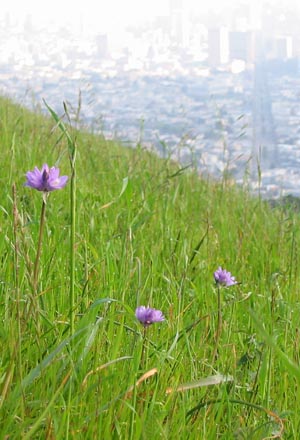 Once upon a time, Twin Peaks stood as one mountain, a united man and wife. But the couple quarreled long and bitterly, until at last the Great Spirit cleaved them with a bolt of lightning. The neighborhood has been quiet ever since -- or so say the chroniclers of Indian legend.
Once upon a time, Twin Peaks stood as one mountain, a united man and wife. But the couple quarreled long and bitterly, until at last the Great Spirit cleaved them with a bolt of lightning. The neighborhood has been quiet ever since -- or so say the chroniclers of Indian legend.
Those Indians, alas no longer here to confirm or deny the tale, likely marked a drastic change in the neighborhood with the arrival of the Spaniards, who fortified the nearby Presidio in 1776 . Maps from this period call Twin Peaks "Los Pechos de la Choca" or "The Breasts of the Indian Maiden," of whom General Vallejo's botanically minded son once remarked, "Never have I seen a cultured woman half so fair as this untaught, unadorned daughter of the wilds."
Young Vallejo may in fact have personified the Franciscan flora, the smallest floristic region in California. This curvaceous landscape of flinty chert and sand dunes supports a body of low-growing coastal scrub and grassland reclining between the regions of Mendocino/Sonoma to the north and the Santa Cruz mountains to the south, both of which favor a taller Douglas fir-redwood association all the way down to the sea. Rich with texture, aroma, and color, our fair maiden helps us define our local identity. Her toes curl around Sign Hill, blazoned with "South San Francisco: The Industrial City" in block letters visible from the freeway and the airport. Her long legs are San Bruno Mountain, stretching for several miles of the inner peninsula with Brisbane and Colma snuggled on either side. Above the rude garter of Daly City her saucy flank swells at Mt. Davidson, then slims to a waistline and rises again to the torso topped with Twin Peaks, shoulders at Diamond Heights and Corona Heights, arms embracing Sunset Heights and Bernal Hill, with long tresses of serpentine flowing out to Bayview and into the Presidio.

